|
|
Post by andy on Mar 29, 2007 11:11:22 GMT
As for the "weed watch" thread, this is for the identification of plant pests...as in bugs !!!! If you can give any description of the damage caused or any relevent infomation, that would be good A photo of the bug is essentialIf you have any specific ways of errdicating the bug, that would be good too but generally speaking, most broad spectrum pesticides bought from garden centres will suffice. Ok....i'll start the bidding with our autumnal favourite, the Leatherjacket  This is the larvae of the cranefly or daddy-long-legs. Whilst the adult flies are harmless, the larvae can sit in the soil all winter happily munching on grass roots. They're not really a problem for most domestic lawns although they can cause yellow patches where the grass dies off which is noticable if you like to keep your lawn nice as opposed to a kids play area. Control is usually by a soil drench available from garden centres |
|
|
|
Post by Rosefriend on Mar 29, 2007 12:18:19 GMT
Aphids 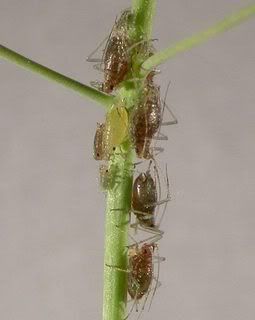 which we also know as Greenfly and Blackfly. Their natural enemies are Ladybirds and lacewings. Aphids produce "honeydew" which is a sugary liquid and entices ants among other things and the ants start "milking" the aphids. Early control is better and some people prefer a soapy/white spirit. spray and others a systematic insecticide. Should there only be a few on a plant one can also squirt them off with water. RF |
|
|
|
Post by andy on Mar 30, 2007 5:24:32 GMT
Mealy bugThis really is a vile pest. Small woodlice type insects sit there and breed and feed on the plant sap. At first, the infestation looks like cotton wool but on closer inspection, little bugs are revealed. Common on most inddor plants and some outdoor species too, it is a very easy bug to kill off using most insecticides or even soapy water. The bugs tend to nestle in leaf axis and will create a sticky honey dew substance similar to aphids. Here are some pics 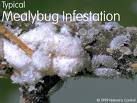  
|
|
|
|
Post by Rosefriend on Mar 31, 2007 13:54:30 GMT
Red Lily Beetle I stopped having lilies in the garden because of these horrors. They can be picked of and the larvae wiped away but chemicals are more often used. 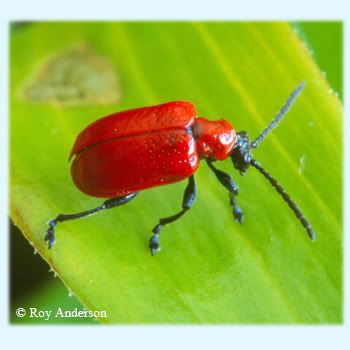 RF |
|
|
|
Post by Rosefriend on Apr 3, 2007 13:05:48 GMT
Webber Moth Caterpillars (other species as well) 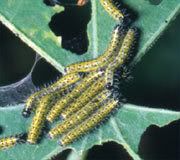 I have had this is my garden and within 2 days a whole shrub was covered in a web and thousands of caterpillar which ate all the leaves. The shrub looked as though it were alive. The only thing that will help is a system insecticide, something containing Pyrethrum if possible. This tends to happen to Cotoneasters and Hawthorns but also as in my case a Euonymus. RF |
|
|
|
Post by Chuckles on Apr 3, 2007 19:59:11 GMT
How about VINE WEEVIL  they are getting to be quite a common bug in the garden these days, particularly in pots but also in the garden. If you have any plants that are looking a bit sad at the moment, they may be being eaten by Vine Weevil grubs which are active at the moment. The adult weevil is a black wingless beetle, it hides away in nooks and crannies in your garden during the day. The adults leave tell tale nibbles on the edge of leaves. My tip would be to go out at night with a torch and hunt them out, a tea bag squeezer is a very useful tool ;D. They lay their eggs in the soil/compo and the larvae are a white/creamish grub with a brown head. These grubs eat the roots of the plants and will eat their way right up into the stem of plants and into bulbs, corms, tubers etc until eventually the plant dies. Any grubs found can be squashed if you are lucky enough to spot the tell tale signs, however I would recommend disposing of the compo very carefully or you will spread the problem. I use a large bucket and put water to the top of the compo and leave it for a couple of weeks so they are killed, they normally float to the top. You can then pop the lot in your compost bin for recycling. You should thoroughly wash off any remaining roots to ensure no grubs are left before replanting. A good off the shelf product to use is Provado, this is a liquid you add to water to treat your pots. It can be used as a preventative or treatment for effect areas. 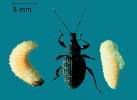  |
|
|
|
Post by Dutchy on Apr 7, 2007 18:34:43 GMT
Question.
Is there a beetle that looks like the Red Lily Beetle?
I all of a sudden find tens of Lilly beetle lookalikes in my living room.
All we could come up with is that they come from the fire wood we brought in.
I have no lilies in the house.
The beetles are less red more of a pinkish brownish red.
The females are bigger than the males.
Help
|
|
|
|
Post by isabella on Apr 7, 2007 20:17:45 GMT
|
|
|
|
Post by Deleted on Apr 8, 2007 15:43:43 GMT
I know this has been posted before I found these in one of my pots today. I think the round balls are the eggs but im not 100% sure.  |
|
|
|
Post by Chuckles on Apr 8, 2007 17:02:03 GMT
The gold coloured balls are thankfully fertiliser granules  But Oh dear Karen quite a few Vine Weevil there  do get some Provado to treat your other pots. It doesn't matter how hard you try and go through the compo you'll always miss a couple of tiny ones. I'm sure I've no need to tell you to make sure you dispose of the larvae, as in kill them one way or another. I use a large bucket and put water to the top of the compo and leave it for a couple of weeks so they are killed, they normally float to the top to start with . As long as your sure their dead you can re-use the compo or pop in your compost bin. |
|
|
|
Post by Dutchy on Apr 8, 2007 17:05:00 GMT
Yes I think that is them Isabella. Thank you.
It is such a relieve to see that it feeds on other insects and not plants.
So to all likeliness it came from the firewood which we got from my friend who lives in the Veluwe an area similar to where these creatures like to live in the UK.
Karen what a lovely collection of vine weevil grubs ;D shifffvvver
I think the round balls are old spend fertilizer.
|
|
|
|
Post by Deleted on Apr 12, 2007 16:42:21 GMT
Thanks for the info about the balls, i wasnt 100% sure but at least i am now.
Im going to get some provado.
|
|